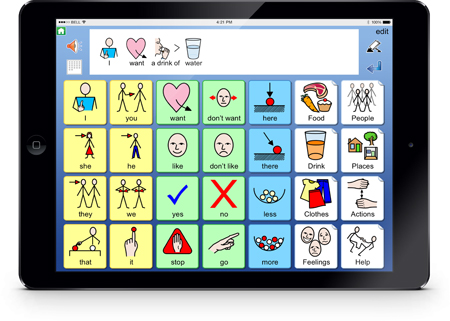Augmentative and Alternative Communication (AAC)
What is Augmentative and Alternative Communication (AAC)?
Augmentative and Alternative Communication (AAC) is any type of communication strategy for people with a range of conditions who have significant difficulties speaking.
There are 2 main types of AAC- aided AAC and unaided AAC
Aided AAC is any external item used to aid communication (e.g. object symbols, communication boards, books, key-ring mini-cards, wallets, speech generating device, computer, mobile phone, tablet). Aided AAC includes both high technology systems and low/light technology systems.
Unaided AAC refers to communication techniques that do not require the use of an external aid. That is, the person uses whatever is available to them, generally their own body. Examples of unaided AAC include using eye contact, facial expression, body language, gestures and manual sign;
Why might someone need to use AAC?
If a person is not able speak they may need a variety of different types of AAC systems to communicate.
Some people also need AAC systems and strategies to understand another person’s message.
People who have difficulties speaking often need both high technology sytems, low technology systems and unaided AAC depending on where they are and with whom they are communicating.
One AAC system or strategy may not be sufficient to meet all of their needs, all of the time.
Who might use AAC?
Many different conditions result in a person having little or no speech and needing AAC to communicate. These include lifelong developmental disabilities such as
cerebral palsy or intellectual disability and conditions that appear later in life such as Parkinson’s disease, motor neuron disease, severe aphasia (language difficulty
following stroke) or acquired brain injury.
There are many other conditions that can result in someone having a temporary or permanent loss of speech, such as burns, surgery after cancer, trauma or being on a breathing tube in the intensive care unit.
Although the range of conditions leading to the use of AAC is very broad, there are many different types of AAC that can suit any person.
There are both ‘off the shelf’ AAC systems such as picture and alphabet boards, and options for designing an individual’s own ‘customised’ AAC system.
Speech therapists are key professionals involved in assessing a person’s communication needs, designing options for AAC systems and making recommendations on which AAC system would be best in different situations.
How does AAC impact on a person's life?
Communication is a basic human right. People who cannot speak encounter difficulties in getting information, building relationships, participating in education and employment and being safe. An AAC system is a way for people to communicate their needs, preferences and ideas.
Using an AAC system will not prevent a child from developing spoken language, or an adult from using whatever speech they can. In fact, using an AAC system can
help to support development of spoken language. Children who use AAC need training and opportunities to practise their developing language skills. It is also important that all users are supported and encouraged to use their system in a range of different settings and situations.
Through many opportunities to practise their skills in different settings, they will not only develop their communication skills but be able to use the system in a wide variety of situations (e.g., taking part in everyday activities, communicating socially, learning opportunities and problem solving).
Almost all domestic, social and learning activities involve some form of communication with other people – so it is important to find ways for the child to ‘have a say’ and ‘understand’ language in everyday situations. This involves more than having an AAC system and making time to communicate – it also involves others being willing to adapt activities so that the AAC user can take part.
(SPA, 2021)

